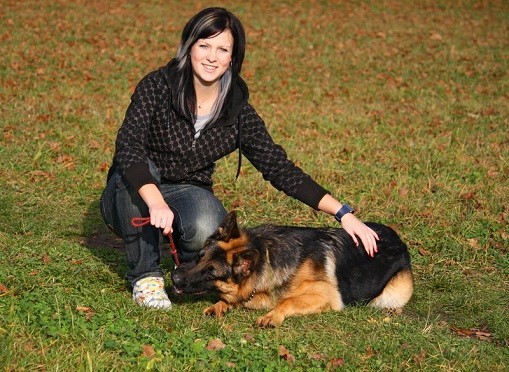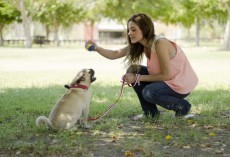Have you ever gone to someones house who has a dog and they got so excited (the dog, not the owner) that they nearly knocked you over? We've been in this situation on more than one occasion. Sometimes we were the ones getting knocked over, other times our dogs were the ones causing our guests clutch the wall for support. But you've gotta start somewhere. And today's post we're going to share some awesome tips that will benefit you and your dog.
Socializing With People
The key to socializing a puppy or a rescued German shepherd is to make sure while you are your introducing your shepherd to new people and acclimating him to a variety of different settings, you are keeping the sessions positive. All it takes is one distressing experience to set back your shepherd and his training.
The situations you place your dog in are out of his control, so it is up to you to make sure your puppy or adult dog is comfortable at all times and not placed into a bad situation.Puppies
A puppy from a good breeder will be born with a predisposition for a certain temperament. Environment: however, can play a key role in determining whether your puppy reaches her full potential as a social dog. In other words, a puppy that is predisposed to be timid and fearful can overcome her fears if she is raised in the right environment. Likewise, a puppy predisposed to be a terrific, friendly dog could be permanently stunted in a harsh and isolated environment.
If you have a puppy, start socialization work immediately. Some experts feel that the puppy should meet 100 strangers within the first 12 weeks of life and visit 50 new places. That is a lot of stimulation. A good start would be to set a goal of meaning at least one new person every day and visiting two or three new locations each week.
When you visit new locations, encourage your puppy to check everything out. Make sure to give her treats to reward good, friendly behavior. Encourage people to pet her so she learns to enjoy handling by different people. Give treats to strangers to offer her so that she associates an outstretched hand with something good.
Your puppy should be comfortable with everyone in your family and anyone who regularly works in your home. For example, if you have children, make sure the babysitter and the puppy are on excellent terms. You do not want to come home to find your sitter trapped in the bathroom with the shepherd standing guard outside the door. She probably will never work for you again.
The Fearful Puppy and Adult Dog
A fearful puppy or adult dog is twice the work of a stable, friendly German shepherd. It requires dedication, time, and patience to draw him out of his shell. Bashful pups need love too and enough time and care from you can turn yours into a delightful dog. Whatever you do, do not use your shepherd's shyness as an excuse not to introduce him to people or to take him places.
Whether working with a puppy or an adult German shepherd dog that is timid, you need to be acutely aware of the subtle body language he will exhibit as he becomes increasingly stressed. When a dog is frightened, his ears may rotate back a little bit. He might begin panting, crouch slightly, tuck his tail in between his legs, or shake. He might also back up or start leaning into you.
Whatever you do, do not force your shepherd to meet anyone. This is not only terrifying to your shepherd, but could also be dangerous for the stranger. The other thing you do not want to do is reward or coddle a frightened shepherd. Instead, move them far enough away from the person so that he is no longer a threat. Let the dog observe the stranger from what he considers a safe distance. Reward him with praise only when he is no longer anxious or showing any signs of stress.
Shy shepherds are highly sensitive to a stranger's body language, movements, and overall demeanor. For this reason, it is important to know the actions that may upset a timid dog.
Some of the things a dog may find threatening include:
- Direct eye contact.
- A hand outstretched above the dog's head.
- Squatting down to the dog's level.
- Putting your face in the dog's face.
- A sharp loud voice.
- Leaning over the dog's back.
If you are making introductions for your dog, tell people not to look him in the eye or pet him, and tell them to let the dog approached them. This will help your shepherd feel much more comfortable with strangers he meets.
Fearful German shepherds require a lot of work to help them overcome their fears. Some shepherds may never be totally comfortable with all people in all situations. Your help; however, will make a significant improvement.
Introducing Friendly Dogs
You also need to socialize your German shepherd with other dogs. This may not seem is critical; however, if you have ever attempted to walk a shepherd that is lunging and barking at every dog he sees, you can appreciate the importance of owning a dog-friendly shepherd. Your neighbors will appreciate it too.
If you own a puppy, begin by introducing him to well-trained dogs that you know are friendly and fully vaccinated. You can introduce the puppy to the other dog in a neutral area, allowing the puppy to approach the adult dog. Even though you have chosen a very friendly dog for your puppy to meet, watch the adult dog carefully for any signs of aggression or attempts to control the puppy.You and your puppy should attend puppy classes as soon as your German shepherd is fully vaccinated. These classes typically include a puppy socialization period prior to the training portion of the class in which the puppies are allowed to romp and play together. The play can sound pretty rough, but for the most part, there is no reason to panic. Playing with other puppies of the same age is one of the ways your puppy will learn to learn good bite inhibition. If he bites a puppy too hard, the puppy will not play with him, which is truly a punishment he will learn from.
If you see that your puppy is being aggressive or picking on another puppy that is becoming distressed, quietly walk up to your puppy and hold his caller. If he is still attacking the other puppy, firmly say, “No!” and calmly remove your puppy from the playgroup. Have him sit next to you for minute, praise him for his good behavior, and then allow him to continue playing.
If your puppy is on the receiving end of a bully's attention, allow him the opportunity to communicate to the bully that he is upset. If he tries and fails or is obviously becoming distressed, step in. Remove your puppy from the situation and consult with the overseeing trainer. The bully should be removed from play.
The list of things your shepherd could find intimidating is VERY important. We recommend that you memorize that list because each bulletpoint can be critical in your dogs socializing development. An outstretched hand above a scared dogs head can result in the dog biting, as they are afraid. Never place your dog in a situation where they can potentially hurt another person. Always practice extra care and inform anyone interested in getting to know your dog that slow movements are best and review the list of intimidating behavior with that individual.
Thanks for all the wonderful tips, German Shepherd US! For the complete list of socializing tips, read their full article here.
Have You Found a Fail-Proof Way to Socialize Your German Shepherd?
If you have been practicing a certain method or socializing technique that has been successful for you and your German Shepherd, we would LOVE to hear about it. Feel free to leave your comments and feedback in the comments section below. Photos and videos are welcomed!










